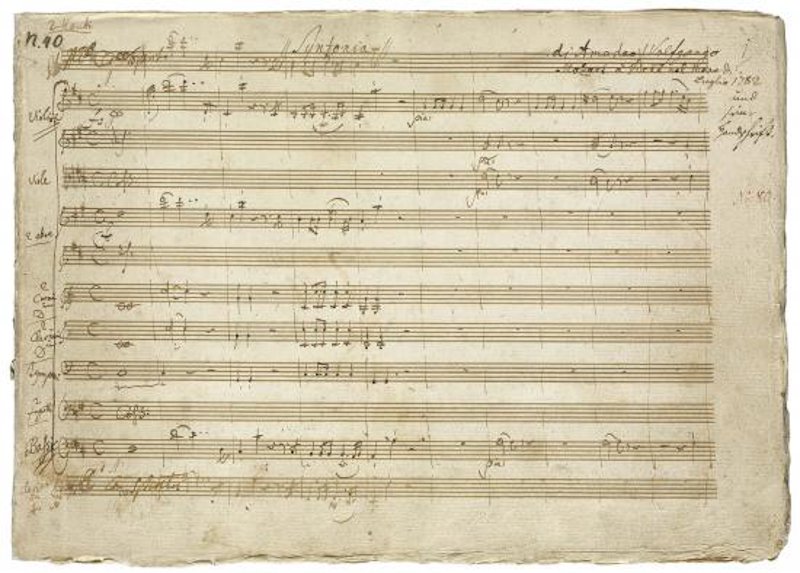Symphony in D major (‘Haffner’) for two violins, viola, basso, two flutes, two oboes, two clarinets, two bassoons, two horns, two trumpets and timpani; the flute and clarinet parts in the first and last movements added later. Mozart’s autograph of the surviving version (see below) is housed at the Pierpont Morgan Library, New York: Di Amadeo Wolfgango Mozart à Vienna nel mese di luglio 1782. The symphony was published in 1785 by the Viennese firm Artaria.

Mozart, Symphony K385 ('Haffner'), first page of the autograph score (New York, Pierpont Morgan Library)
In 1776, Mozart was commissioned to compose a serenade (K250) for the wedding of Franz Xaver Späth and Maria Elisabeth Haffner, a daughter of the Salzburg mayor Siegmund Haffner. When Elisabeth Haffner’s brother, Siegmund d.J., was ennobled in 1782, Mozart was again asked to write a work to celebrate the event. The history of the composition of this new serenade, eventually redacted by Mozart as a symphony, is partly documented in letters Mozart wrote to his father:
20 July 1782: I’ve lots of work at the moment. – By Sunday week I have to arrange my opera[1] for wind band – otherwise someone else will get in first – and they’ll be the one to profit from it, not me;[2] and I’m also supposed to be writing a new symphony! – How shall I ever manage? – You can’t imagine how difficult it is to arrange such a thing for wind band – so that it suits the wind instruments and yet loses none of its effectiveness. – Oh well, I’ll just have to sit up all night working on it, there’s no other way – and to you, my dearest father, may it be sacrificed. – You’ll certainly receive something every post day, and I’ll work as quickly as possible – and as far as haste allows, I’ll make a good job of it. –
27 July 1782: You’ll no doubt be surprised to receive only the first allegro; but – I’d no choice – I’ve had to write a Nacht Musique[3] in a hurry, but only for wind band – otherwise I could have used it for you too – on Wednesday the 31st I’ll send you the 2 minuets[4], the andante and the final movement – if I can, I’ll also send a march – if not you’ll have to make do with the one from the Haffner music[5] – which is very little known – I’ve written it in D as I know you prefer it.
31 July 1782: You see that my intentions are good – only what one cannot do, one cannot! I am really unable to scribble off inferior stuff. So I cannot send you the whole symphony until next post day. I could have let you have the last movement, but I prefer to send it all together, for then it will cost only one postage.
7 Aug 1782: Enclosed is a short march![6]– I only hope that everything arrives in good time – and that it’s to your liking. – The first allegro must be very fiery. – The last – as fast as possible.
In December 1782, Mozart asked his father to return the ‘Haffner’ — either in the original score or a copy — adding, ‘I should like to have it for certain before Lent, for I would very much like to perform it at my concert’ (letter of 21 December 1782). He received it in February, writing to Leopold: ‘My new Haffner symphony has positively amazed me, for I had forgotten every single note of it. It must surely produce a good effect’ (letter of 15 February). Mozart redacted the work by eliminating one of the two minuets and the march, and adding a flute and clarinet parts to the outer movements. Neither the full score of the original serenade nor the dropped minuet survives, only Mozart’s symphony redaction.
[1] Die Entführung aus dem Serail K384.
[2] In the event, Mozart did not complete a wind arrangement of Die Entführung aus dem Serail.
[3] Almost certainly the wind serenade K388; in 1782 Mozart also revised the wind serenade K375, a work that is similarly described as a ‘Nacht Musique’.
[4] One of the minuets is lost.
[5] The ‘Haffner’ serenade K250 and its associated march, K249, composed in July 1776.
[6] Probably K408/2.
- Category/Role
- Symphony
- Author/Creator
- Mozart, Wolfgang Amadeus